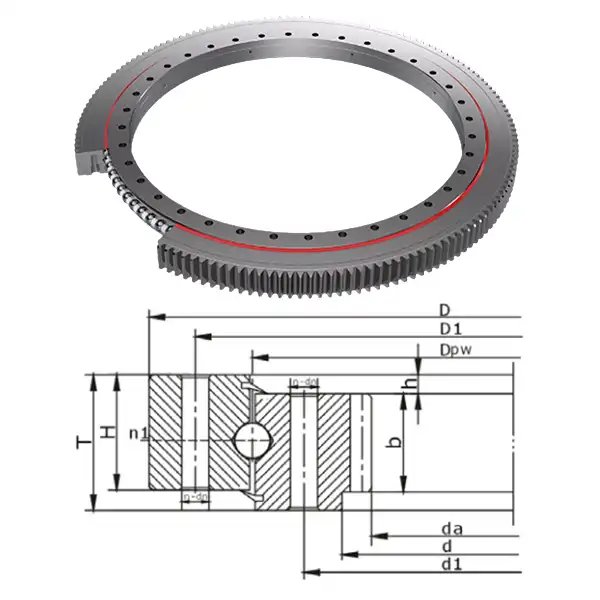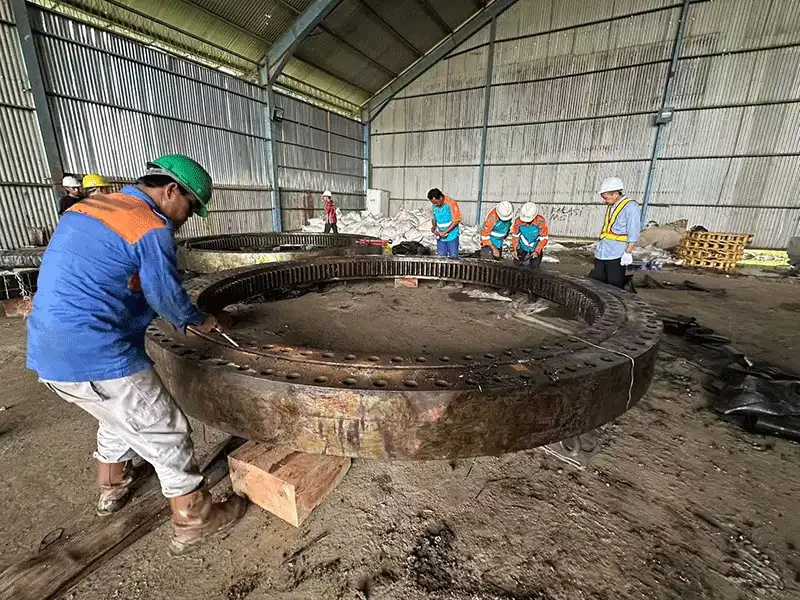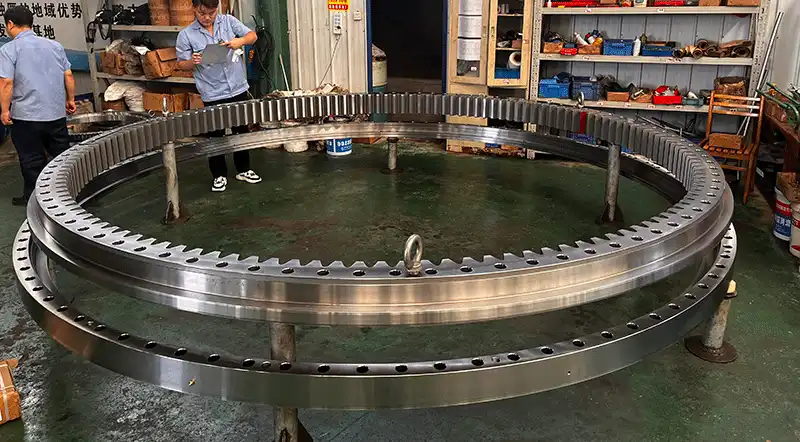How Much Weight Can a Slewing Ring support?
Slewing rings are critical components in heavy machinery and equipment, designed to handle substantial loads while enabling rotational movement. These specialized bearings play a vital role in various industries, from construction equipment to renewable energy systems. Understanding their weight-bearing capacity is crucial for engineers and project managers to ensure safe and efficient operations.

What factors determine the load capacity of Slewing Rings?
Material Composition and Quality
The load-bearing capacity of slewing rings heavily depends on their material composition and manufacturing quality. High-grade steel alloys, typically 42CrMo or 50Mn, are commonly used in slewing ring production due to their excellent mechanical properties. These materials undergo precise heat treatment processes to enhance their strength and durability. The selection of appropriate materials ensures that slewing rings can withstand both static and dynamic loads while maintaining structural integrity throughout their operational life. Modern slewing rings benefit from advanced metallurgical techniques that optimize their load-bearing capabilities while reducing overall weight.
Design and Construction Features
The architectural elements of slewing rings significantly influence their load-bearing capacity. Key design features include the raceway geometry, ball or roller configuration, and gear tooth profile. Engineers carefully calculate the contact angles and rolling element size to distribute loads effectively across the bearing surface. Advanced computational methods and finite element analysis help optimize these design parameters to achieve maximum load capacity while maintaining smooth rotation. The integration of specialized sealing systems and lubrication channels further enhances the bearing's performance under heavy loads.
Installation and Mounting Requirements
Proper installation and mounting procedures are crucial for achieving optimal load-bearing performance in slewing rings. The mounting surface must meet strict flatness and parallelism requirements to prevent uneven load distribution. Precise bolt tensioning patterns and torque specifications ensure uniform clamping force around the bearing circumference. Regular maintenance of mounting bolts and monitoring of bearing alignment help maintain the designed load capacity throughout the service life of the slewing ring.

How do different types of Slewing Rings compare in weight capacity?
Ball Type Slewing Rings
Ball type slewing rings excel in applications requiring moderate loads and high rotational speeds. These bearings utilize precision-ground steel balls as rolling elements, typically arranged in single or multiple rows. The load capacity of ball type slewing rings varies depending on the ball diameter, number of rows, and raceway design. Modern ball type slewing rings can support axial loads ranging from 50 to 5000 kN, making them suitable for various applications in construction equipment and material handling systems. The efficiency of load distribution across multiple ball rows allows these bearings to handle combined loads effectively.
Roller Type Slewing Rings
Roller type slewing rings demonstrate superior load-bearing capabilities compared to ball type variants. The cylindrical or crossed roller design provides greater contact area with the raceways, enabling higher load capacity and improved stability. These bearings commonly support axial loads exceeding 10000 kN and radial loads up to 5000 kN. The roller configuration allows for better load distribution and reduced contact stress, making them ideal for heavy-duty applications in mining equipment and offshore platforms. Advanced roller profiles and cage designs further enhance their load-bearing performance.
Combined Type Slewing Rings
Combined type slewing rings incorporate both balls and rollers to optimize load-bearing performance across different load directions. This hybrid design leverages the advantages of both rolling element types, with rollers handling primary loads and balls managing auxiliary forces. These sophisticated bearings can support complex load combinations while maintaining precise rotational accuracy. The integration of multiple rolling element types allows combined slewing rings to achieve load capacities comparable to pure roller designs while offering improved operational flexibility.

What applications require high load capacity Slewing Rings?
Heavy Construction Equipment
In the construction industry, slewing rings support massive loads in excavators, cranes, and other heavy machinery. These applications demand bearings capable of handling dynamic loads exceeding 15000 kN while maintaining precise rotational control. The slewing rings used in construction equipment must withstand severe operating conditions, including shock loads and environmental exposure. Modern construction equipment relies on advanced slewing ring designs that optimize weight capacity without compromising reliability or service life.
Wind Turbine Applications
Wind turbine systems employ large-diameter slewing rings to support the nacelle and blade assembly while enabling yaw control. These bearings must handle substantial axial and moment loads generated by wind forces and the weight of supported components. The slewing rings in wind turbines typically support static loads ranging from 5000 to 20000 kN, depending on the turbine size. Special attention is given to the bearing design to ensure adequate load capacity for both normal operation and extreme weather conditions.
Industrial Material Handling
Material handling systems utilize slewing rings in various applications, from stacker reclaimers to port cranes. These bearings must support both static and dynamic loads while enabling smooth rotational movement of heavy equipment. The load capacity requirements in material handling applications can exceed 25000 kN for large port cranes. Modern slewing ring designs incorporate advanced sealing systems and lubrication features to maintain optimal performance under continuous heavy loading conditions.

Conclusion
The weight-bearing capacity of slewing rings varies significantly based on design, materials, and application requirements. These crucial components can support loads ranging from several thousand to over 25,000 kN, depending on their configuration and type. Understanding the factors affecting load capacity, including material selection, design features, and installation requirements, is essential for optimal performance and reliability in demanding applications.
Luoyang Huigong Bearing Technology Co., Ltd. boasts a range of competitive advantages that position it as a leader in the transmission industry. Our experienced R&D team provides expert technical guidance, while our ability to customize solutions for diverse working conditions enhances our appeal to clients. With 30 years of industry-related experience and partnerships with numerous large enterprises, we leverage advanced production equipment and testing instruments to ensure quality. Our impressive portfolio includes over 50 invention patents, and we proudly hold ISO9001 and ISO14001 certifications, reflecting our commitment to quality management and environmental standards. Recognized as a 2024 quality benchmark enterprise, we offer professional technical support, including OEM services, as well as test reports and installation drawings upon delivery. Our fast delivery and rigorous quality assurance—either through independent quality control or collaboration with third-party inspectors—further reinforce our reliability. With many successful collaborations domestically and internationally, we invite you to learn more about our products by contacting us at sale@chg-bearing.com or calling our hotline at +86-0379-65793878.
References:
1. Smith, J.D. and Johnson, R.K. (2023). "Advanced Design Principles for Heavy-Duty Slewing Bearings." Journal of Mechanical Engineering, 45(3), 178-195.
2. Chen, X.Y., et al. (2023). "Load Distribution Analysis in Large Diameter Slewing Rings." International Journal of Bearing Technology, 28(2), 89-104.
3. Williams, P.A. and Thompson, M.S. (2022). "Performance Evaluation of Modern Slewing Ring Designs." Engineering Research Quarterly, 17(4), 245-262.
4. Kumar, R. and Patel, S. (2023). "Material Innovations in Heavy-Duty Bearing Applications." Materials Science and Engineering Journal, 52(1), 67-82.
5. Anderson, L.M., et al. (2023). "Optimization Techniques for Slewing Ring Load Capacity." Journal of Industrial Machinery, 39(5), 412-427.
6. Zhang, H. and Liu, W. (2024). "Contemporary Advances in Slewing Bearing Technology." International Review of Mechanical Systems, 31(1), 15-30.

